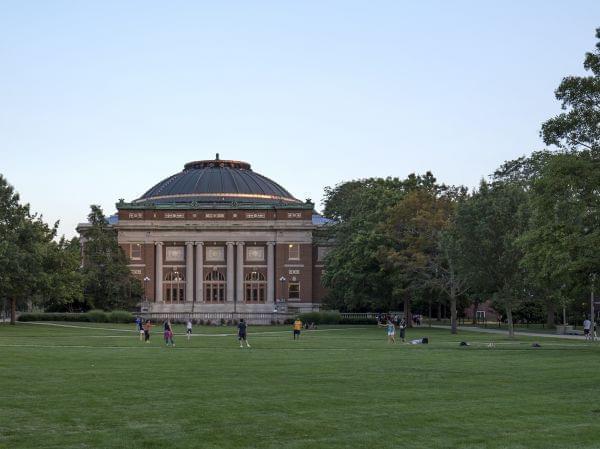Amid Rising Housing Costs, Free Tuition Is Just One Piece Of College Affordability

Students on the University of Illinois Quad. Travis Stansel/Illinois Public Media
Beginning this fall, the University of Illinois at Urbana-Champaign will offer free tuition to admitted Illinois students from households that make $61,000 or less. But not included in the free tuition program is the cost of room and board, which has risen dramatically in recent decades at universities around the country.
“Generally non-tuition expenses are a huge part of college affordability and students perceptions of whether or not they can afford college,” said Kevin McClure, an associate professor of higher education at the University of North Carolina Wilmington who has studied how college policies and practices encourage or inhibit affordability.
One of the largest non-tuition expenses is the cost of living on campus. The cost of room and board doubled in inflation adjusted dollars at public universities in the U.S. between 1980 and 2014, according to a 2017 report from the Urban Institute.
McClure said any initiative to reduce the cost of attendance, like free tuition programs in some states, is a step in the right direction, but the cost of housing is an often overlooked part of the equation.
“In a perfect scenario, any of these programs that are really trying to make college truly affordable for low-income students would account for the important role that housing and non-tuition costs play,” McClure said.
In 1980, the average cost of room and board was about $1,800, around $5,000 adjusted for inflation. The average cost of room and board at public universities this year has jumped to more than $11,000, according to data from the College Board.
For Mary Moliski, a sophomore at the U of I studying animal science, the cost of housing generally wasn't as much of a concern as the cost of housing over breaks.
“It's $40 a night to stay for three weeks, and that's $840, which is more than rent for a whole month,” Moliski said.
Moliski didn’t have a home to return to when classes let out for vacations. She came to the U of I from Chicago, where she had been living at the Mercy Home for Boys and Girls, a shelter and welfare agency for young people. She was able to get a scholarship to cover the cost of tuition and housing on campus from the Mercy Home, but she said break housing is just one of the many expenses low-income and homeless students often have to worry about that students with a larger financial safety net may not consider.
“Getting people here is one thing but retaining them is an entirely different conversation,” Moliski said.

Mary Moliski is a sophomore at the U of I working on a project that focuses on community for low-income and homeless students on campus.
She found help through a professor who offered her a house sitting gig over the break, but she says not all students in her situation are so fortunate, or feel comfortable speaking up about their circumstances. Her personal experience has motivated her to work with the Clinton Global Initiative (CGI) University on a project to help reduce the stigma many homeless and low-income university students feel, and help to connect them with resources and peer support.
“I was very lucky in that I told my advisor what my situation was and she was able to connect me with one of the professors I worked for,” Moliski said. “But I can't believe that everybody happens to work for somebody who rents out a house to students.”
There are grants and federal loans available to help students pay for the cost of housing during the school year, but even with that help, students can be left footing a large portion of the bill.
A 2018 report from the National College Access Network found that even after grants, aid, and loans, public four-year colleges are not affordable in 43 states for students living on-campus, unless a student works full-time over the summer. For students living off-campus, that number increases to 46 states.
McClure said there are a few possible explanations for this rise in housing costs. One is that many public university housing departments are self-sustaining, meaning they operate almost entirely on what students pay for their housing or for their rent. When housing operating costs go up, those can get passed on to students.
Mari Anne Brocker Curry is Associate Director of Housing for Housing Information and Marketing at the U of I. She says their university housing department doesn’t receive any additional funding from the state.
“We’re really trying to balance that affordability and accessibility with the cost to do business and trying to figure out how to manage those two sometimes competing priorities,” Brocker Curry said.
She said they want to be an affordable and accessible form of housing where students can get services they won’t find off-campus, like staff in the halls, 24-hour maintenance, meals or educational support. But she says they’re feeling pressure from private developers competing for student renters.
“These new buildings can’t all be full. There’s not enough students,” Brocker Curry said. “And a lot of our students who used to choose to return to university housing aren’t doing that anymore.”
McClure says private developers view students as a lucrative rental market in college towns around the country, and are another factor in increased housing costs. He refers to this as “upscaling.”
“If the off-campus housing is upscaling and creating new options with new amenities for students it creates pressures for on campus housing,” McClure said.
So while students like Mary Moliski think free tuition is a great step, she says that’s not all it will take to make low-income students feel at home on a college campus. And it’s not just the cost of living either.
“Being poor is incredibly exhausting,” Mosliski said. “It's a level of emotional labor and being on edge and planning ahead that students with a bigger security net or safety net just don't have to think about or do.”

